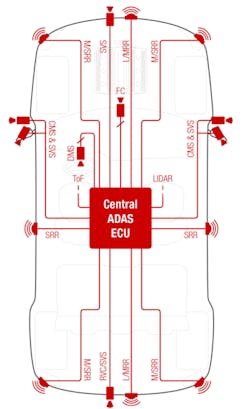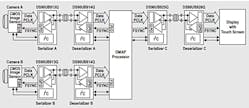Members can download this article in PDF format.
In the automotive industry, technologies that influence advanced driver-assistance systems (ADAS) are evolving rapidly. Applications range from basic vehicle functions such as lighting, braking, and cruise control to more complex uses like engine and transmission control, traffic warnings, proximity to other cars, and correct lane use.
Because highly automated and connected cars will rely on more than one type of network architecture, designers are being challenged to employ multiple network technologies simultaneously. The goal is to communicate critical information in real-time and with precision to keep drivers informed about operational data and the status of the vehicle.
This is causing automakers to simplify automotive networks and adopt more centralized processing architectures. A processor is needed to take in data from various modules and output data from multiple inputs and interfaces.
The challenge here is the fact that the quantity of data transmitted and received is no longer in the hundreds of kilobits per second. Rather tens of gigabits per second communication is needed to be safe, secure and in real-time over fewer wires. This, in turn, demands improved data speed and reliability in automotive communication technologies.
Multiple-camera systems, which are a rapidly growing segment in the market for automotive safety and assistance, require real-time vision analysis (Fig. 1). To design high-performance camera systems without sacrificing critical resources, TI’s Arm-based processors help engineers create customizable solutions that allow for large amounts of traffic to be transferred across a wide variety of physical networks.
In addition to network design assistance, these elements help you create an optimized power-distribution solution in zonal modules. The zonal controller is, essentially, a networking platform that allows designers to simplify the wiring harness, which then reduces cost and weight. The rapid move to electric vehicles provides a window of opportunity for the shift to zonal architectures, and the first generation of zonal controller is already becoming standard in many production vehicles.
Industry's First Chipset for Ultrasonic Lens Cleaning
Removing contaminants from camera lenses traditionally requires manual cleaning, causing system downtime, or the use of various mechanical parts that could malfunction. In the design of reliable automotive multi-camera systems ultrasonic-lens-cleaning (ULC) devices enable automatic detection and cleaning.
Leveraging ULC technology, TI’s integrated circuits reduce the size and maintenance required for camera cleaning systems. Among their features are autosensing, temperature monitoring, and fault detection.
TI’s new ULC chipset, including the ULC1001 digital signal processor (DSP) and companion DRV2901 piezo transducer driver, features a proprietary technology that allows cameras to rapidly self-clear contaminants. Precisely controlled vibrations to rapidly eliminate debris help improve system accuracy and reduce maintenance requirements. The chipset offers designers a compact and affordable way to use ULC in a wide range of applications and camera sizes.
SerDes FPD-Link
Automotive networks are tasked with moving massive amounts of data to process and help make decisions. This is where TI’s FPD-Link interface devices come into play.
FPD-Link is a proprietary automotive SerDes technology developed for real-time, uncompressed transmission. Specifically, FPD-Link was developed to transport video data within the car, enabling enhanced data analysis and processing in driver-assistance applications (Fig. 2).
For example, it can be used to send uncompressed video to a display while the back channel sends information from an external-facing camera to the processor. The processor uses image processing and algorithms to send a command signal back to the car or driver, such as for automatic braking.
TI’s FPD-Link technology acts as a bridge between protocol-based data interfaces, which require multiple signaling conductors to transfer high bandwidth data. Simply put, FPD-Link is a multi-protocol physical-layer technology that aggregates data from various industry-standard protocols.
Such devices enable the aggregation of data from various protocols coming out of a processor into a single or dual pair of wires. They also provide a back channel for simultaneous data transfer, like touch-control data from display panels back to the vehicle processing unit. It streamlines design and delivery of high-resolution signals for a variety of video interfaces across automotive systems, including cameras and infotainment displays.
The SerDes supports uncompressed video, control, and power over a single low-latency cable while also providing adaptive equalization to compensate for cable again and temperature changes. In addition, FPD-Link can be applied to other types of data transfers, such as LiDAR, radar, and more.
To achieve this, the serializer must reformat its incoming data and embed the data clock so that it can be output using fewer conductors. FPD-Link also allows for full-duplex communication over one physical conductor. FPD-Link applications typically utilize either coaxial or twisted-pair cable to carry the information between serial and deserializer.
Conclusion
ADAS is a stepping-stone toward fully autonomous cars and commercial vehicles. The goal of an ADAS system is to bolster vehicle safety by making drivers aware of possible issues, helping to avoid collisions and simplifying daily vehicle operation.
To accomplish that, ADAS features generate an ever-increasing amount of data that needs to be processed, and communicated securely and safely across interfaces such as CAN, LIN, and networks like Ethernet. These requirements are pushing automakers to simplify automotive networks and adopt more centralized processing architectures, integrating TI’s FPD-Link serializer/deserializer technology into their ADAS or infotainment applications.


